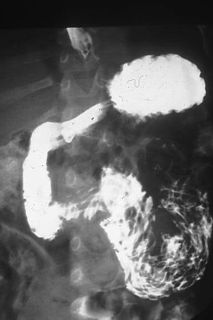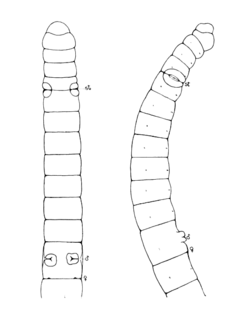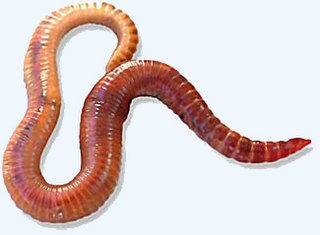Related Research Articles
The Morris worm or Internet worm of November 2, 1988, was one of the first computer worms distributed via the Internet, and the first to gain significant mainstream media attention. It also resulted in the first felony conviction in the US under the 1986 Computer Fraud and Abuse Act. It was written by a graduate student at Cornell University, Robert Tappan Morris, and launched on November 2, 1988, from the computer systems of the Massachusetts Institute of Technology.

Ascariasis is a disease caused by the parasitic roundworm Ascaris lumbricoides. Infections have no symptoms in more than 85% of cases, especially if the number of worms is small. Symptoms increase with the number of worms present and may include shortness of breath and fever in the beginning of the disease. These may be followed by symptoms of abdominal swelling, abdominal pain, and diarrhea. Children are most commonly affected, and in this age group the infection may also cause poor weight gain, malnutrition, and learning problems.
mydoom also known as W32.MyDoom@mm, Novarg, Mimail.R and Shimgapi, is a computer worm affecting Microsoft Windows. It was first sighted on January 26, 2004. It became the fastest-spreading e-mail worm ever, exceeding previous records set by the Sobig worm and ILOVEYOU, a record which as of 2021 has yet to be surpassed.

The slow worm is a reptile native to western Eurasia. It is also called a deaf adder, a slowworm, a blindworm, or regionally, a long-cripple. These legless lizards are also sometimes called common slowworms. The "blind" in blindworm refers to the lizard's small eyes, similar to a blindsnake.

Helminthiasis, also known as worm infection, is any macroparasitic disease of humans and other animals in which a part of the body is infected with parasitic worms, known as helminths. There are numerous species of these parasites, which are broadly classified into tapeworms, flukes, and roundworms. They often live in the gastrointestinal tract of their hosts, but they may also burrow into other organs, where they induce physiological damage.

Dracunculiasis, also called Guinea-worm disease, is a parasitic infection by the Guinea worm. A person becomes infected from drinking water that contains water fleas infected with guinea worm larvae. Initially there are no symptoms. About one year later, the female worm forms a painful blister in the skin, usually on a lower limb. Other symptoms at this time may include vomiting and dizziness. The worm then emerges from the skin over the course of a few weeks. During this time, it may be difficult to walk or work. It is very uncommon for the disease to cause death.

Mesenchytraeus solifugus, commonly called an ice worm, is a species of oligochaete worm that inhabits coastal glaciers in northwestern North America. M. solifugus is dark brown and grows to about 15 mm long and 0.5 mm wide. It has a high population density and is common in suitable habitat. It can only survive at temperatures of approximately –7 °C to 5 °C. The ice worm is studied for its ability to survive in low temperatures. It has heavy pigment, absorbing most colors; however, it burrows into the glacier to avoid strong sunlight.
ILOVEYOU, sometimes referred to as Love Bug or Love Letter for you, is a computer worm that infected over ten million Windows personal computers on and after 5 May 2000 when it started spreading as an email message with the subject line "ILOVEYOU" and the attachment "LOVE-LETTER-FOR-YOU.TXT.vbs". The latter file extension, was most often hidden by default on Windows computers of the time, leading unwitting users to think it was a normal text file. Opening the attachment activates the Visual Basic script. The worm inflicts damage on the local machine, overwriting random types of files, and sends a copy of itself to all addresses in the Windows Address Book used by Microsoft Outlook. This made it spread much faster than any other previous email worm.

Eisenia fetida, known under various common names such as manure worm, redworm, brandling worm, panfish worm, trout worm, tiger worm, red wiggler worm, etc., is a species of earthworm adapted to decaying organic material. These worms thrive in rotting vegetation, compost, and manure. They are epigean, rarely found in soil. In this trait, they resemble Lumbricus rubellus.

Dracunculus medinensis, or Guinea worm, is a nematode that causes dracunculiasis, also known as guinea worm disease. The disease is caused by the female which, at up to 80 centimetres in length, is among the longest nematodes infecting humans. In contrast, the longest recorded male Guinea worm is only 4 cm.

Eradication is the reduction of an infectious disease's prevalence in the global host population to zero.

Cornelia Isabella "Cori" Bargmann is an American neurobiologist. She is known for her work on the genetic and neural circuit mechanisms of behavior using C. elegans, particularly the mechanisms of olfaction in the worm. She has been elected to the National Academy of Sciences and had been a Howard Hughes Medical Institute investigator at UCSF and then Rockefeller University from 1995 to 2016. Since 2016 she is Head of Science at the Chan Zuckerberg initiative. In 2012 she was awarded the $1 million Kavli Prize, and in 2013 the $3 million Breakthrough Prize in Life Sciences.

The nematodes or roundworms constitute the phylum Nematoda, with plant-parasitic nematodes also known as eelworms. They are a diverse animal phylum inhabiting a broad range of environments. Taxonomically, they are classified along with insects and other moulting animals in the clade Ecdysozoa, and unlike flatworms, have tubular digestive systems with openings at both ends. Like tardigrades they have a reduced number of Hox genes, but as their sister phylum Nematomorpha has kept the ancestral protostome Hox genotype, it shows that the reduction has occurred within the nematode phylum.
Jonathan Alan Hodgkin is a British biochemist, Professor of Genetics at the University of Oxford, and an emeritus fellow of Keble College, Oxford.
Goniadidae is a family of marine worms within the Polychaeta. Goniadids have long, slender bodies and can grow up to 260mm in length, although most are less than 50mm long. Goniadids have an eversible proboscis with a circlet of chitinous jaws around the terminal end.
Aonides trifida is a bristle worm from the Spionidae family. Aonides trifida has a pointed head, two pairs of eyes and grows up to 100mm in length. Aonides trifida is a surface deposit feeder and bioturbator which tolerates a sediment mud content up to 80%, but has an optimum range of 0-5%.
Magelona dakini is a small, thin, shovel-nosed burrowing worm with limited mobility. Adults grow up to 70mm long. Magelonids build meandering burrows, usually below the top 20mm of sediment, in medium to fine sands. They occur across the mid-intertidal and subtidal zones to the continental slope.
Cossura consimilis is a polychaetid worm that was distributed throughout New Zealand. Cossura consimilis is a slender thread-like worm with a blunt head, growing up to 20mm in length. Cossura consimilis live in muddy sand in shallow intertidal harbours and estuaries, to the inner continental shelf and out to the continental slope. Cossura consimilis tolerates a sediment mud content of 5 to 65%, with an optimum range of 20-25%.
Orbinia papillosa is a polychaetid worm distributed throughout New Zealand. Orbinia papillosa has a small pointed head without eyes. Adults can grow in size to more than 100mm long, but are less than 2mm in width.

The COVID-19 pandemic in Cuzco is part of the worldwide pandemic of coronavirus disease 2019 caused by severe acute respiratory syndrome coronavirus 2. The virus was reported to have spread to Cuzco on 13 March 2020, when a 37-year-old man who had travelled to United States tested positive. The start of the epidemic outbreak in The country, also called "community transmission", was announced on March 17, 2020, while the first death was reported a week later. As time passed, the outbreak spread throughout the department, Paruro being the last province to report its first positive case on May 6, 2020. In the district of Villa Virgen, La Convención Province, a first positive case of contagion by COVID-19 was confirmed on August 24, 2020, becoming the last district of the department to declare the presence of infected persons. The exponential increase in infections, which occurred since the third week of July, positioned Cuzco as the third department with the most cases in Peru.
References
- ↑ Singleton, Nathan (2010). Regional Estuary Monitoring Programme (REMP) Data Report: Benthic Macrofauna Communities and Sediments – July 2007 to April 2008 (Report). Waikato Regional Council. Retrieved 2021-02-18.
- ↑ Langeneck, J; Barbieri, M; Maltagliati, F; Castelli, A (2019). "Molecular phylogeny of Paraonidae (Annelida)". Molecular Phylogenetics and Evolution. 136: 1–13. doi:10.1007/s12237-015-0036-2 . Retrieved 2021-02-19.